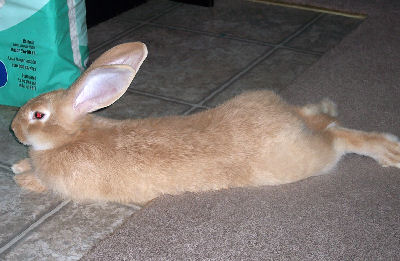The Flemish Giant first came to fame in America in the early 1900's , when people began to show off these giant beauties at county fairs and shows. Like the New Zealand White, they are highly prized for both their meat and their fur, and make excellent pets due to their docile and friendly natures.
As with all rabbits, it is important to get your Flemish Giant Rabbit used to being handled, and to associate you with positive things. Because these rabbits are relatively large, the bite or scratch you get from them will be much more painful than that of a mini lop or dwarf breed. Having said that, if you treat your bunny well, bites and scratches are more of a rarity than a rule.
A Flemish Giant may be a good choice if you are looking for something with a relaxed temperament that doesn't need to run around like a mad thing too much. Unlike their smaller counterparts, Flemish Giants are quite happy to lay around a fair bit, though be warned, they do consume a lot more feed than smaller rabbits.
If you're considering a Flemish Giant, also consider the cage you will need for these bunnies. 30 by 48 inches is considered to be the smallest acceptable floor space for a single Flemish Giant, though larger quarters are of course, encouraged.
Flemish Giants come in a range of colors, light greys, sandy tones, darker greys, fawns, whites, blacks, and blues are all possible colors for a Flemish Giant.
An average Flemish Giant generally weighs around 6.5 to 7 kgs, or 14 - 15.5 pounds. If you would like to show your Flemish Giant Rabbit, or would simply like to know what the breed's ideal standards are, here are a few things to look out for:
Head: The Flemish Giant has a large and well shaped head. The eyes should be bright and alert, and the ears should stand nicely erect.
Body: The body of a Flemish Giant Rabbit should be long and powerful. It should be in proportion throughout the entire body. The hindquarters should be nice and thick, and the flesh of the rabbit should be solid and well formed. The fur should be glossy and thick set.
Faults: Too much fat is considered a fault in Flemish Giant Rabbits, as is baggy skin. The coat should be even in color, so patchy colored coats are frowned upon. The rump should be nicely rounded, so square looking hindquarters are not good, neither are wedge shaped heads, or ears that are not carried nicely erect.

Tidak ada komentar:
Posting Komentar